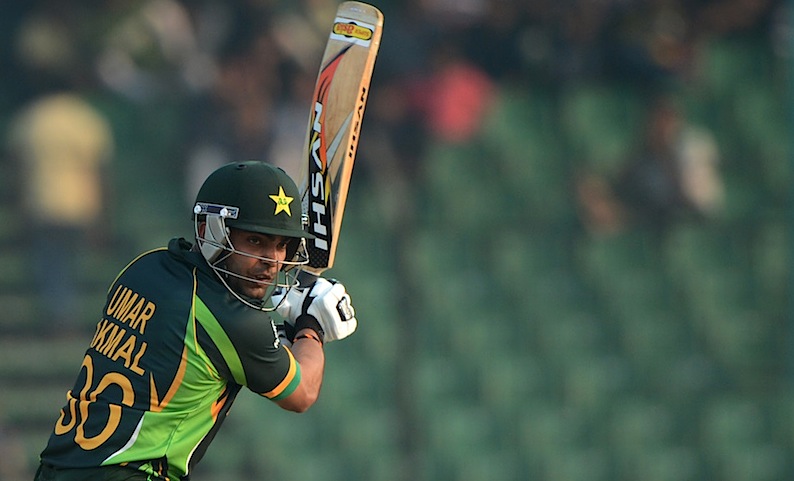In the last few years the Pakistani cricket team has performed relatively better in Test and T20 cricket than it has in the ODI format. It is somewhat perplexing that a team doing well in the shortest and the longest form of the game often comes up short in a format that falls in between. But in a world with many inexplicable phenomenons, failure usually follows a pattern.
The Pakistani batting is known to be its Achilles heel, but its dissolution off late has adhered to a sequence of repeated events; an embarrassing top order collapse, followed by a painful middle order resurrection, before an eventual lower order disintegration. Amongst the many follies of Pakistan cricket, it is the imbalanced flow of energy in an ODI innings that catches the naked eye of millions of observers. A typical Pakistani innings crashes before it takes off.
Let’s monitor the energy flow in the batting line-up of the top three teams playing the Asia Cup.

India and Sri Lanka, like other teams have its best batsmen coming in the top four. While Misbah-ul-Haq and Umar Akmal who appear to be Pakistan’s best batsmen by some distance, invariably come to the crease amidst a collapse at number five and six. Unlike Test cricket, in ODIs, quite simply, the batsmen coming in first can potentially play more overs than the batsmen walking in after. Also unlike T20 cricket, the winning team often needs a batsman that can play as an anchor and ideally reach the magical three figure mark. In a combined total of 6,901 runs in 234 matches, the duo of Misbah and Umar have 54 half-centuries but only two centuries to their credit.
Pakistan’s asymmetric batting order causes a lopsided effect in building an innings. Instead of formulating a solid base with a top-heavy batting line like the rest of the world, Pakistan is far too often made to reconstruct after early wreckage of a rickety top order. Apart from an apparent lack of batting resources, Pakistan has been unsuccessful in optimally utilising their current assets. The absurdity seems to spread or maybe stem from the team combination of the squad and the eventual playing XI.
The team selection quandary for Pakistan comes in the form of its all-rounders; Shahid Afridi, Mohammad Hafeez and Bilawal Bhatti are match winners on their day but each one of them is a bowling all-rounder. With Saeed Ajmal, Junaid Khan and Umar Gul, Pakistan is effectively playing with six full-time bowlers, while Sohaib Maqsood is also capable of turning his off spinning arm in times of need; Pakistan seems to play with one bowling option too many.
Umar Gul was the pick of the bowlers in the opening game of the Asia Cup but could only bowl eight overs. Junaid Khan, with an average of 23.34 and an economy rate of 4.94, has had an exceptional start to his career but has bowled out his quota only 7 times in 44 matches. In a fifty over game, at least one or more full time bowlers will always remain under employed.
While Pakistan’s top order woes are well known, their lower order batting has become equally fatal. Once Misbah and Umar depart, there is no one to hold the fort. While Afridi and Bhatti have a modest combined first class average of 25.37, Indian and Sri Lankan batsmen at number 7 and 8 average of 43.12 and 49.45 respectively. At the same batting number, Australia has Brad Hadin and James Faulkner, South Africa has Ryan McLaren and Wayne Parnell, while England play Ben Stokes and Jos Buttler. In modern cricket these positions are reserved for batsmen who are specialist ‘finishers’ of an ODI innings.
When Bhatti is replaced with someone like Anwar Ali, the problem still persists and the imbalance is maintained. Pakistan needs to send its best batsmen up the order to lay a foundation instead of working on damage control. If your best batsman keeps running out of partners or overs, he is contributing below his capacity. And if he is the captain, the onus is on him. Pakistan should also replace one of its bowling all-rounders with a batsman who can provide the all-important batting depth that Pakistan so desperately needs. It is usually not a question of picking the best XI players, but selecting the most efficient team combination and using it at its optimal output.
The current 15-man squad has three more bowlers in reserve (Abdur Rehman, Bilawal Bhatti / Anwar Ali and Mohammad Talha) and only one extra batsman (Fawad Alam). Pakistan is infamous for a brittle batting line-up but has travelled to Bangladesh with as many as nine bowlers (including bowling all-rounders), only five batsmen and a forced wicket keeper.













































